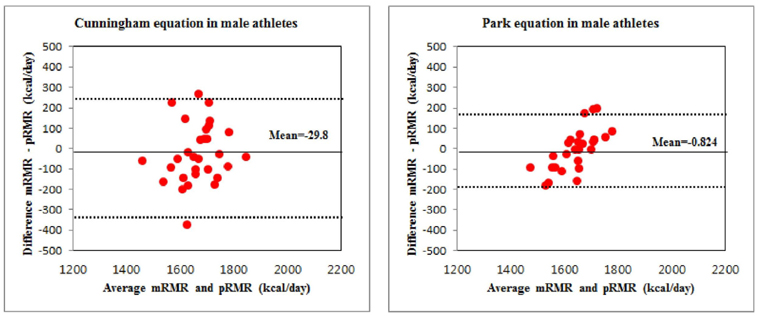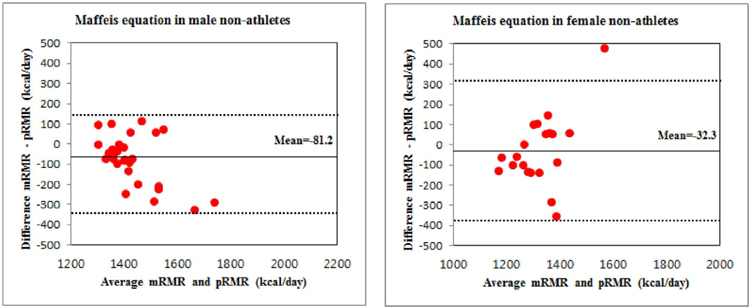Nutr Res Pract.
2015 Aug;9(4):370-378. 10.4162/nrp.2015.9.4.370.
Accuracy of predictive equations for resting metabolic rate in Korean athletic and non-athletic adolescents
- Affiliations
-
- 1Department of Food and Nutrition, Gangneung-Wonju National University, 7 Jukheon-gil, Gangneung-si, Gangwon-do, 210-702, Korea. ekkim@gwnu.ac.kr
- KMID: 2313853
- DOI: http://doi.org/10.4162/nrp.2015.9.4.370
Abstract
- BACKGROUND/OBJECTIVES
Athletes generally desire changes in body composition in order to enhance their athletic performance. Often, athletes will practice chronic energy restrictions to attain body composition changes, altering their energy needs. Prediction of resting metabolic rates (RMR) is important in helping to determine an athlete's energy expenditure. This study compared measured RMR of athletic and non-athletic adolescents with predicted RMR from commonly used prediction equations to identify the most accurate equation applicable for adolescent athletes.
SUBJECTS/METHODS
A total of 50 athletes (mean age of 16.6 +/- 1.0 years, 30 males and 20 females) and 50 non-athletes (mean age of 16.5 +/- 0.5 years, 30 males and 20 females) were enrolled in the study. The RMR of subjects was measured using indirect calorimetry. The accuracy of 11 RMR prediction equations was evaluated for bias, Pearson's correlation coefficient, and Bland-Altman analysis.
RESULTS
Until more accurate prediction equations are developed, our findings recommend using the formulas by Cunningham (-29.8 kcal/day, limits of agreement -318.7 and +259.1 kcal/day) and Park (-0.842 kcal/day, limits of agreement -198.9 and +196.9 kcal/day) for prediction of RMR when studying male adolescent athletes. Among the new prediction formulas reviewed, the formula included in the fat-free mass as a variable [RMR = 730.4 + 15 x fat-free mass] is paramount when examining athletes.
CONCLUSIONS
The RMR prediction equation developed in this study is better in assessing the resting metabolic rate of Korean athletic adolescents.
Keyword
MeSH Terms
Figure
Reference
-
1. Speakman JR, Selman C. Physical activity and resting metabolic rate. Proc Nutr Soc. 2003; 62:621–634.
Article2. Watson S, Buell J. Body composition, resting metabolic rate and dietary habits of lean and non-lean female athletes [honors thesis]. Columbus (OH): Ohio State University;2009.3. Thompson J, Manore MM. Predicted and measured resting metabolic rate of male and female endurance athletes. J Am Diet Assoc. 1996; 96:30–34.
Article4. Heymsfield SB, McManus C, Smith J, Stevens V, Nixon DW. Anthropometric measurement of muscle mass: revised equations for calculating bone-free arm muscle area. Am J Clin Nutr. 1982; 36:680–690.
Article5. Du Bois D, Du Bois EF. Tenth paper A formula to estimate the approximate surface area if height and weight be known. Arch Intern Med (Chic). 1916; 17:863–871.6. Weir JB. New methods for calculating metabolic rate with special reference to protein metabolism. J Physiol. 1949; 109:1–9.
Article7. Harris JA, Benedict FG. A Biometric Study of Basal Metabolism in Man. Washington, D.C.: Carnegie institution of Washington;1919.8. Food and Agriculture Organization (US). World Health Organization(CH). United Nations University (US). Energy and Protein Requirement. Report of a Joint FAO/WHO/UNU Expert Consultation. WHO Technical Report Series No.724. Geneva (CH): World Health Organization;1985.9. Mifflin MD, St Jeor ST, Hill LA, Scott BJ, Daugherty SA, Koh YO. A new predictive equation for resting energy expenditure in healthy individuals. Am J Clin Nutr. 1990; 51:241–247.
Article10. Owen OE, Kavle E, Owen RS, Polansky M, Caprio S, Mozzoli MA, Kendrick ZV, Bushman MC, Boden G. A reappraisal of caloric requirements in healthy women. Am J Clin Nutr. 1986; 44:1–19.
Article11. Altman PL, Dittmer DS. Metabolism. Bethesda (MD): Federation of American Societies for Experimental Biology;1968.12. Schofield WN. Predicting basal metabolic rate, new standards and review of previous work. Hum Nutr Clin Nutr. 1985; 39:Suppl 1. 5–41.13. Panel on Macronutrients. Panel on the Definition of Dietary Fiber. Subcommittee on Upper Reference Levels of Nutrients. Subcommittee on Interpretation and Uses of Dietary Reference Intakes. Standing Committee on the Scientific Evaluation of Dietary Reference Intakes. Food and Nutrition Board. Institute of Medicine of the National Academies (US). Chapter 5. Energy. Dietary Reference Intakes for Energy, Carbohydrate, Fiber, Fat, Fatty Acids, Cholesterol, Protein, and Amino Acids. Washington D.C.: The National Academies Press;2002. p. 107–264.14. Lawrence JC, Lee HM, Kim JH, Kim EK. Variability in results from predicted resting energy needs as compared to measured resting energy expenditure in Korean children. Nutr Res. 2009; 29:777–783.
Article15. De Lorenzo A, Bertini I, Puijia A, Testolin G, Testolin C. Comparison between measured and predicted resting metabolic rate in moderately active adolescents. Acta Diabetol. 1999; 36:141–145.
Article16. Kim EK, Kim GS, Park JS. Comparison of activity factor, predicted resting metabolic rate, and intakes of energy and nutrients between athletic and non-athletic high school students. J Korean Diet Assoc. 2009; 15:52–68.17. Maffeis C, Schutz Y, Micciolo R, Zoccante L, Pinelli L. Resting metabolic rate in six- to ten-year-old obese and nonobese children. J Pediatr. 1993; 122:556–562.
Article18. Cunningham JJ. Body composition as a determinant of energy expenditure: a synthetic review and a proposed general prediction equation. Am J Clin Nutr. 1991; 54:963–969.
Article19. Park JS. Assessment of physical activity, resting metabolic rate(RMR), energy expenditure and comparison of predicted RMR with measured RMR and development of prediction equations for RMR between athletic and non-athletic male high school students [master's thesis]. Gangneung: Gangneung-Wonju National University;2008.20. Bland JM, Altman DG. Statistical methods for assessing agreement between two methods of clinical measurement. Lancet. 1986; 1:307–310.
Article21. Gilliat-Wimberly M, Manore MM, Woolf K, Swan PD, Carroll SS. Effects of habitual physical activity on the resting metabolic rates and body compositions of women aged 35 to 50 years. J Am Diet Assoc. 2001; 101:1181–1188.
Article22. Poehlman ET, Melby CL, Badylak SF. Resting metabolic rate and postprandial thermogenesis in highly trained and untrained males. Am J Clin Nutr. 1988; 47:793–798.
Article23. Horton TJ, Geissler CA. Effect of habitual exercise on daily energy expenditure and metabolic rate during standardized activity. Am J Clin Nutr. 1994; 59:13–19.
Article24. Schulz LO, Nyomba BL, Alger S, Anderson TE, Ravussin E. Effect of endurance training on sedentary energy expenditure measured in a respiratory chamber. Am J Physiol. 1991; 260:E257–E261.
Article25. Wilmore JH, Wambsgans KC, Brenner M, Broeder CE, Paijmans I, Volpe JA, Wilmore KM. Is there energy conservation in amenorrheic compared with eumenorrheic distance runners? J Appl Physiol (1985). 1992; 72:15–22.
Article26. Mulligan K, Butterfield GE. Discrepancies between energy intake and expenditure in physically active women. Br J Nutr. 1990; 64:23–36.
Article27. Myerson M, Gutin B, Warren MP, May MT, Contento I, Lee M, Pi-Sunyer FX, Pierson RN Jr, Brooks-Gunn J. Resting metabolic rate and energy balance in amenorrheic and eumenorrheic runners. Med Sci Sports Exerc. 1991; 23:15–22.
Article28. Ravussin E, Lillioja S, Knowler WC, Christin L, Freymond D, Abbott WG, Boyce V, Howard BV, Bogardus C. Reduced rate of energy expenditure as a risk factor for body-weight gain. N Engl J Med. 1988; 318:467–472.
Article29. Chang UJ, Lee KR. Correlation between measured resting energy expenditure and predicted basal energy expenditure in female college students. J Korean Soc Food Sci Nutr. 2005; 34:196–201.
Article30. Lee DO, Lee CJ. An analysis on body composition development trend of youth. Korean J Phys Educ. 2001; 40:899–911.31. Firouzbakhsh S, Mathis RK, Dorchester WL, Oseas RS, Groncy PK, Grant KE, Finklestein JZ. Measured resting energy expenditure in children. J Pediatr Gastroenterol Nutr. 1993; 16:136–142.
Article32. Finan K, Larson DE, Goran MI. Cross-validation of prediction equations for resting energy expenditure in young, healthy children. J Am Diet Assoc. 1997; 97:140–145.
Article33. Dietz WH, Bandini LG, Schoeller DA. Estimates of metabolic rate in obese and nonobese adolescents. J Pediatr. 1991; 118:146–149.
Article34. Rodríguez G, Moreno LA, Sarría A, Fleta J, Bueno M. Resting energy expenditure in children and adolescents: agreement between calorimetry and prediction equations. Clin Nutr. 2002; 21:255–260.
Article35. Valencia ME, Moya SY, McNeill G, Haggarty P. Basal metabolic rate and body fatness of adult men in northern Mexico. Eur J Clin Nutr. 1994; 48:205–211.36. Owen OE, Holup JL, D'Alessio DA, Craig ES, Polansky M, Smalley KJ, Kavle EC, Bushman MC, Owen LR, Mozzoli MA, Kendrick ZV, Boden GH. A reappraisal of the caloric requirements of men. Am J Clin Nutr. 1987; 46:875–885.
Article
- Full Text Links
- Actions
-
Cited
- CITED
-
- Close
- Share
- Similar articles
-
- Comparison of Activity Factor, Predicted Resting Metabolic Rate, and Intakes of Energy and Nutrients Between Athletic and Non-Athletic High School Students
- Accuracy of Predictive Equations for Resting Metabolic Rate in Korean College Students
- Effect of Short Termed Fasting on the Usage Patterns of Metabolic Energy Sources during Exercise in Man
- Accuracy of Four Resting Metabolic Rate Predictive Equations in Obese Women
- Accuracy of Accelerometer for the Prediction of Energy Expenditure and Activity Intensity in Athletic Elementary School Children During Selected Activities




